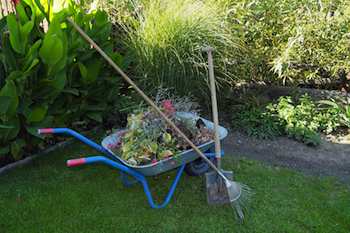By Sean Conway

Fall is an ideal time to clean up your garden, improve your soil and take other steps to prepare for next spring's planting
The cooler temperatures and shortened days of fall may have signaled some of the plants in my vegetable garden to slow down, but they are sure signs for me to speed things up. Fortunately, I am more motivated to work now that the summer heat has subsided -- and with the amount of work that needs to be done around here, that's a good thing.
Keeping a vegetable garden looking respectable requires regular vigilance. Over the years, I have found that many of my gardening friends tend to give up on their gardens once fall arrives. When their gardens go through the end of summer explosion of produce, and plants are growing helter-skelter the way vegetables do, they get frustrated, feel like they have lost control, and walk away until the following spring.
I find that continued maintenance in the garden -- weeding, cultivating and removing tired old plants -- keeps my garden looking good and at the same time motivates me to continue working in it. In many ways, it is easier to garden in the cooler temperatures of fall. Weeds don't grow as fast, fungal problems are less of an issue, and pest activity seems to slow down as fall progresses.
Although many of the vegetable plants in my garden are no longer producing at their August "bonanza" levels, the garden certainly hasn't stopped dead in its tracks. As I mentioned last week, cooler temperatures are perfect for growing lettuce, radishes, broccoli, kale, arugula and other cool-loving vegetables. I start planting cool-loving crops like these at the end of August and continue to sowing seeds and transplanting seedlings well into September and October.
Even if you don't have the energy to keep planting through the fall, cleaning up your garden as it begins to decline is a great way to get a jump on next year's garden. Start by removing dead plants or plants that are clearly no longer producing. Cut back decaying leaves off of perennial plants such as rhubarb or chives, and remove dead tops from plants like onions. Clean and store all plant supports and be sure to remove any plastic or nylon plant ties so they don't get tilled under next spring.
Adding soil amendments now, such as composted manure or garden compost, will improve your soil over the coming months and give you one less chore to do come spring. Planting cover crops such as oats or cowpeas helps prevent soil erosion over the winter and adds nitrogen back to the soil. Tilling them under in the spring will further improve the tilth of your soil. Sow cover crops now to give them time to germinate before cold temperatures set in.
Once you have things cleaned up, take a soil sample and have your soil tested. Knowing what your garden soil needs well before planting time help ensure success, and gives you time to add any necessary amendments. Some amendments take months to produce results, so testing your soil in the fall gives you a jump on spring.
If you keep up with the fall cleanup, your workload will be manageable and you will not feel like the garden has gotten away from you. Not only will your garden look neat and well cared for; it will also be ready and waiting for you next spring.
Available at Amazon.com:
Trowel and Error: Over 700 Tips, Remedies and Shortcuts for the Gardener
Cut Your Energy Bills Now: 150 Smart Ways to Save Money & Make Your Home More Comfortable & Green
It's Easy Being Green: A Handbook for Earth-Friendly Living
Copyright © Cultivating Life by Sean Conway. All rights reserved.
AUTOS | HOBBIES | EDUCATION | FAMILY | FASHION | FOOD & RECIPES | HOME DECOR | RELATIONSHIPS | PARENTING | PETS | TRAVEL | WOMEN
Home & Garden - Getting and Keeping Your Garden in Shape for Next Spring